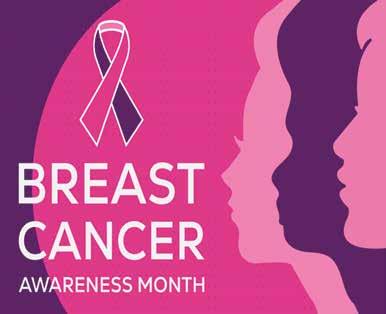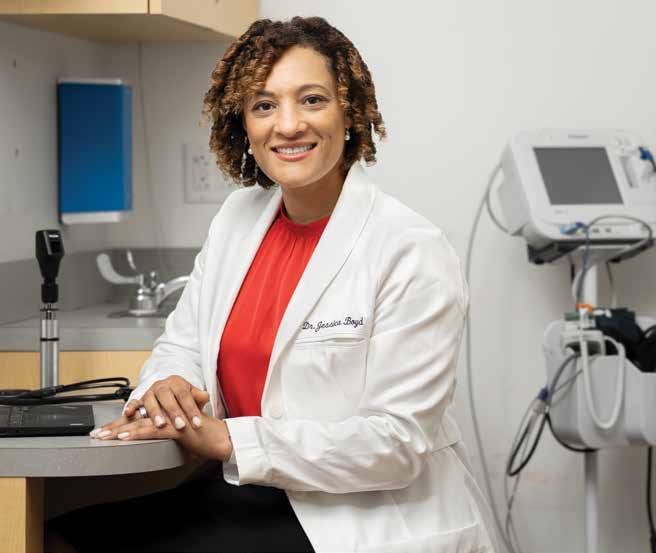
5 minute read
Health
Symptoms of Breast Cancer and the Importance of Prevention
Natalie C. Hockaday WI Staff Writer
As the nation observes Breast Cancer Awareness Month, now throughout the remainder of the month, Black women continue to die at higher rates compared to other racial and ethnic groups in the U.S.
According to the U.S. Department of Health and Human Services, Office of Minority Health, Black women were just as likely to be diagnosed with breast cancer but 40 times more likely to die from the disease compared to non-Hispanic white women. In the Cancer Facts & Figures for African Americans 2019-2021 by the American Cancer Society, it states that overall Non-Hispanic Black women have a seven percent lower risk of a cancer diagnosis but a 13 percent higher risk of death of cancer overall.
The fact sheet shows that Black women are less likely to be diagnosed with breast cancer in the localized stage which is a stage where the invasive cancer is confined in the organ in which it originates. Black women are more likely to be diagnosed in further stages such as regional and distant where the cancer spreads to surrounding organs, tissues, or nearby lymph nodes and even further to distant organs and lymph nodes during the distant stage.
Incidence rates of breast cancer are higher for Black women under the age of 45 compared to white women according to the American Cancer Society. The median age for diagnosis among Black women is 59 compared to 63 for white women.
Black women in the U.S. are also twice as likely to be diagnosed with triple negative breast cancers compared to other racial and ethnic women in the country. According to the American Cancer Society, women with this type of breast cancer have worse outcomes due to effective treatments not yet being developed.
With breast cancer being the most common cancer among women, they’re encouraged to be screened by getting a mammogram. When getting a mammogram, an x-ray photo is taken of breasts to detect early signs of breast cancer. Besides getting mammograms, women are also encouraged to check their breasts and underarms for any new lumps. More symptoms of breast cancer according to the CDC include thickening or swelling of part of the breast, irritation or dimpling of breast skin, redness or flay skin in the nipple area or breast, pulling in of the nipple, nipple discharge other than breast milk (including blood), any change in the size or shape of the breast or pain in the breast. WI
5 Breast Cancer Awareness Month (Courtesy photo)
Mark your calendars for Whitman-Walker’s 35th annual Walk & 5K to End HIV on Saturday, October 23, 2021!

Register online at WalktoEndHIV.org
WALK & RUN TO END HIV. WALK & RUN TO ENSURE EQUALITY. WALK & RUN TO FIGHT RACISM. WALK & RUN TO LOVE OPENLY. WALK & RUN TO SAVE LIVES.
Study Finds High Rates of Orphanhood Connected to COVID-19
Natalie C. Hockaday WI Staff Writer
A clear correlation has been detected between child orphanhood and COVID-19 deaths.
A recent American Academy of Pediatrics study found that from April 1, 2020 to June 30, 2021, there have been over 140,000 children who experienced the death of a parental or grandparent caregiver. Minority children made up 91,256 of the children who lost their primary caregiver and white children made up 51,381 children who lost their primary caregiver.
Until the pandemic becomes fully controlled, Dr. Susan Hillis, Centers for Disease Control [CDC] researcher and lead author of the study, says rates will continue to rise and with the numbers increasing since the study began. In record time, the number has risen to nearly 175,000 children who face orphanhood due to the COVID-19 pandemic.
“Certainly we care about every child who is facing COVID-19-associated orphanhood. Every one of them is important,” Dr. Hillis said. “By the end of June there were more than 140,000 children that had been impacted. This is basically for every four COVID-19 deaths a child is left behind without a mother or a father or the grandparent who owned or paid the rent in the house and provided their needs.”
The study states that children whose caregivers have died from COVID-19 have a possibility of experiencing “intensified trauma and may have an immediate need for kinship or foster care at a time when the pandemic restrictions may limit access to protective services.”
Hillis suggested a fourth pillar called “Care for Children” to be added to the COVID-19 response. This pillar has a three-pronged approach to prevent, prepare and protect. The prevent pillar serves to prevent the death of parents and caregivers by supporting vaccines eequity. The prepare pillar would create support for family-based alternative care which would help children who have lost their caregivers. The last part seeks to protect children with evidence-based interventions that strengthen positive parenting and protect children who have a surviving caregiver alongside having economic support and educational growth.
Disparities continue within the ongoing issue of orphanhood among children with minority children being more likely to have a death of a caregiver due to COVID-19. The study found that even though whites account for 61% of the U.S. population, white children make up 35% of children who lost a caregiver due to COVID-19. This lower percentage stands in contrast with other ethnic racial groups who make up lower percentage rates of the total population but have higher orphanhood rates due to COVID-19. The study estimates that “ethnic minorities account for 65% of children losing primary caregivers, compared to 39% of the total population.”
The pandemic has hit minority communities in disproportionate ways holistically. The findings of the study address how children are impacted beyond contracting the illness itself. It’s estimated that one-of-753 white children have experienced death of a caregiver (parent or grandparent) and one-of-168 American Indian/Alaska Native children have experienced the death of a caregiver.
There’s also a disproportionate loss for racial and ethnic minority children when it comes to the loss of their caregiver with factors which contribute to this discrepancy. The study outlines how there remain “structural and social determinants of health, such as discrimination, neighborhood environment, barriers in access to healthcare, occupation, educational gaps, economic instability, living arrangements and unstable housing.” WI

(Courtesy photo)
At Unity, you can smoothly schedule a vaccine appointment online at unityhealthcare.org or call 202-469-4699.
Be a hero. Get the shot to protect our people.
Let’s end the COVID-19 pandemic together. Get the shot.






